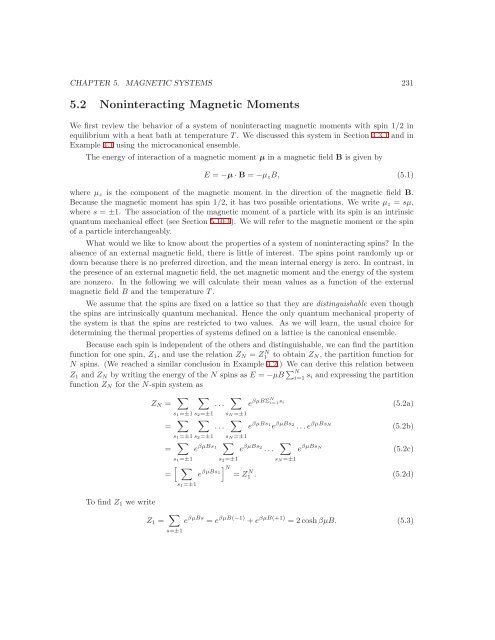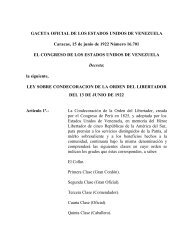Chapter 5 - WebRing
Chapter 5 - WebRing
Chapter 5 - WebRing
You also want an ePaper? Increase the reach of your titles
YUMPU automatically turns print PDFs into web optimized ePapers that Google loves.
CHAPTER 5. MAGNETIC SYSTEMS 231<br />
5.2 Noninteracting Magnetic Moments<br />
We first review the behavior of a system of noninteracting magnetic moments with spin 1/2 in<br />
equilibrium with a heat bath at temperature T. We discussed this system in Section 4.3.1 and in<br />
Example 4.1 using the microcanonical ensemble.<br />
The energy of interaction of a magnetic moment µ in a magnetic field B is given by<br />
E = −µ·B = −µzB, (5.1)<br />
where µz is the component of the magnetic moment in the direction of the magnetic field B.<br />
Because the magnetic moment has spin 1/2, it has two possible orientations. We write µz = sµ,<br />
where s = ±1. The association of the magnetic moment of a particle with its spin is an intrinsic<br />
quantum mechanical effect (see Section 5.10.1). We will refer to the magnetic moment or the spin<br />
of a particle interchangeably.<br />
What would we like to know about the properties of a system of noninteracting spins? In the<br />
absence of an external magnetic field, there is little of interest. The spins point randomly up or<br />
down because there is no preferred direction, and the mean internal energy is zero. In contrast, in<br />
the presence of an external magnetic field, the net magnetic moment and the energy of the system<br />
are nonzero. In the following we will calculate their mean values as a function of the external<br />
magnetic field B and the temperature T.<br />
We assume that the spins are fixed on a lattice so that they are distinguishable even though<br />
the spins are intrinsically quantum mechanical. Hence the only quantum mechanical property of<br />
the system is that the spins are restricted to two values. As we will learn, the usual choice for<br />
determining the thermal properties of systems defined on a lattice is the canonical ensemble.<br />
Because each spin is independent of the others and distinguishable, we can find the partition<br />
function for one spin, Z1, and use the relation ZN = ZN 1 to obtain ZN, the partition function for<br />
N spins. (We reached a similar conclusion in Example 4.2.) We can derive this relation between<br />
Z1 and ZN by writing the energy of the N spins as E = −µB N i=1si and expressing the partition<br />
function ZN for the N-spin system as<br />
To find Z1 we write<br />
ZN = <br />
<br />
s1=±1 s2=±1<br />
= <br />
<br />
s1=±1 s2=±1<br />
= <br />
s1=±1<br />
e βµBs1<br />
<br />
= e βµBs1<br />
Z1 = <br />
s=±1<br />
s1=±1<br />
... <br />
sN=±1<br />
... <br />
sN=±1<br />
<br />
s2=±1<br />
N = Z N 1<br />
e βµBΣN<br />
i=1 si (5.2a)<br />
e βµBs1 e βµBs2 ...e βµBsN (5.2b)<br />
e βµBs2 ... <br />
sN=±1<br />
e βµBsN (5.2c)<br />
. (5.2d)<br />
e βµBs = e βµB(−1) +e βµB(+1) = 2coshβµB. (5.3)

















